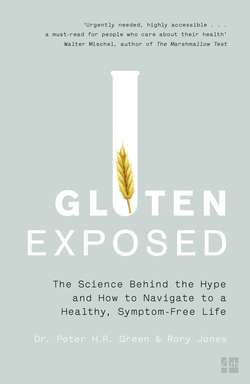Читать книгу Gluten Exposed: The Science Behind the Hype and How to Navigate to a Healthy, Symptom-free Life - Rory Jones, Dr. Green Peter - Страница 43
The Problem Protein
ОглавлениеProtein is not just found in meat, fish, eggs, and cheese; it is an essential part of many foods. It is the protein portion of wheat—both the gluten and nongluten parts—that gives the small intestine of many people the most trouble. For those with celiac disease, the troublemaker is gliadin, the protein portion of wheat and several other grains. It contains one fraction that is not readily digested. So despite all the grinding, churning, mixing, and battering of digestion, some proteins remain intact. Gluten is a major culprit in this scenario.
But scientists are learning that for those with IBS and other gluten sensitivities, it may be the nongluten portion of wheat contributing to the problem. (See chapter 11, “Gluten and Nongluten Grains.”)
Fat
Fat is one of the major building blocks of the body. It provides long-term energy stores and needed cholesterol. While many people take statins to lower their cholesterol, it is the main component of cell membranes and is needed to maintain the integrity of every cell in the body and to make many hormones.
Mineral and Vitamin Digestion
Specific minerals and vitamins are crucial to body growth, function, and metabolism. Even minor deficiencies disrupt body chemistry.
Vitamins are either water or fat soluble. Water-soluble vitamins, the B family and C, move across the watery chyme quite easily either on their own or assisted by special carriers. Fat-soluble vitamins must be emulsified to make the trip. Sodium (salt), calcium, iron, water, potassium, and other trace minerals are readily absorbed in different parts of the small intestine, but if the villi are damaged, minerals and vitamins cannot be absorbed.
The Colon (Large Intestine)
Whatever is left of the chyme in the small intestine is then pushed by peristalsis into the colon or large intestine. For many people, this is the part of the digestive tract where painful problems occur.
The digestive process that starts in the mouth culminates in the colon, which is about 6 feet long, shorter than the “small” intestine.
The colon is home to a huge population of bacteria (the microbiota) that have colonized your intestine throughout your lifetime. They feast on everything the small intestine has discarded and digest much of the unused fiber in our diet through fermentation—the bacterial version of chemical conversion. This reduces the chyme into feces and releases folic acid and vitamins B1, B2, B6, B12, and K (the clotting vitamin).
In fact, while the main function of the colon is the absorption of water, approximately 98 percent of the fluids entering from the small intestine—as well as a small but significant percentage of our calories—is actually absorbed in the large intestine. It is the fermentation process that produces carbon dioxide and methane gas, which often translates into flatulence (gas).
As the food is pushed through the colon, the fecal matter becomes more and more concentrated and then stored until it is eliminated through the rectum. The longer it takes to expel feces, the more water is absorbed, making the stool harder and, in turn, more difficult to expel. Diets high in fiber (raw fruits and vegetables, high-fiber cereals) or supplemented with drugstore fiber (e.g., Metamucil or FiberCon) create more fecal bulk that goes largely unabsorbed and creates larger stools.
